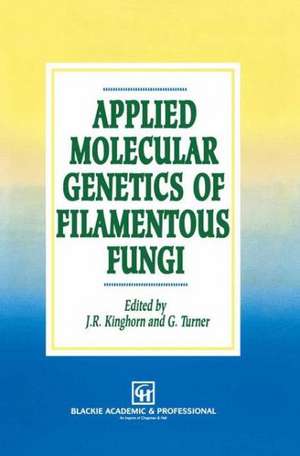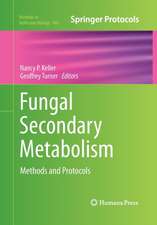Applied Molecular Genetics of Filamentous Fungi
Editat de J.R. Kinghorn, Geoffrey Turneren Limba Engleză Hardback – 31 aug 1992
| Toate formatele și edițiile | Preț | Express |
|---|---|---|
| Paperback (1) | 1215.85 lei 6-8 săpt. | |
| SPRINGER NETHERLANDS – 4 oct 2012 | 1215.85 lei 6-8 săpt. | |
| Hardback (1) | 1221.83 lei 6-8 săpt. | |
| SPRINGER NETHERLANDS – 31 aug 1992 | 1221.83 lei 6-8 săpt. |
Preț: 1221.83 lei
Preț vechi: 1490.03 lei
-18% Nou
Puncte Express: 1833
Preț estimativ în valută:
233.83€ • 243.22$ • 193.04£
233.83€ • 243.22$ • 193.04£
Carte tipărită la comandă
Livrare economică 14-28 aprilie
Preluare comenzi: 021 569.72.76
Specificații
ISBN-13: 9780751400588
ISBN-10: 0751400580
Pagini: 259
Ilustrații: XII, 259 p.
Dimensiuni: 155 x 235 x 18 mm
Greutate: 0.56 kg
Ediția:1992
Editura: SPRINGER NETHERLANDS
Colecția Springer
Locul publicării:Dordrecht, Netherlands
ISBN-10: 0751400580
Pagini: 259
Ilustrații: XII, 259 p.
Dimensiuni: 155 x 235 x 18 mm
Greutate: 0.56 kg
Ediția:1992
Editura: SPRINGER NETHERLANDS
Colecția Springer
Locul publicării:Dordrecht, Netherlands
Public țintă
ResearchCuprins
1 Fungal technology.- 1.1 Introduction.- 1.2 Selective markers.- 1.3 Transformation procedures.- 1.4 Fate of transforming DNA in Aspergillus nidulans.- 1.5 Expression vectors.- 1.6 Karyotyping.- 1.7 Restriction fragment length polymorphism mapping.- References.- 2 Gene organization in industrial filamentous fungi.- 2.1 Introduction.- 2.2 Gene structure.- 2.3 Gene regulation.- 2.4 Prospects.- References.- 3 Fungal enzymes used in oriental food and beverage industries.- 3.1 Introduction.- 3.2 Fungal industries in Japan.- 3.3 Fungal industries in China.- 3.4 Modern industries based on fungal enzymes.- 3.5 Genetic transformation systems for Rhizopus.- 3.6 Proteolytic enzymes.- 3.7 Pectinolytic enzymes and RNases.- 3.8 Lipases.- 3.9 Fungal enzymes used in starch processing.- 3.10 Summary.- References.- 4 Fungal enzymes for lignocellulose degradation.- 4.1 Introduction.- 4.2 Cellulose degradation.- 4.3 Hemicellulose degradation.- 4.4 Lignin degradation.- 4.5 Applications.- References.- 5 Foreign proteins.- 5.1 Introduction.- 5.2 Industrial enzymes and food products.- 5.3 Proteins of pharmaceutical interest.- 5.4 Expression of other proteins.- 5.5 Scale-up, production and regulatory aspects.- 5.6 Future prospects.- References.- 6 Stability of recombinant strains under fermentation conditions.- 6.1 Introduction.- 6.2 Fermentation.- 6.3 Isolation and stability of chymosin-producing strains.- 6.4 Regulatory issues.- 6.5 Preservation of recombinant fungal strains.- 6.6 Conclusions.- References.- 7 Molecular biology of filamentous fungi used for biological control.- 7.1 Introduction.- 7.2 Mechanisms of biological control activity.- 7.3 Strain improvement.- 7.4 Molecular markers for the characterization of biocontrol fungi.- References.- 8 The application of biotechnology to the button mushroom, Agaricus bisporus.- 8.1 Introduction.- 8.2 Biological barriers to mushroom strain development.- 8.3 Systematic isolation and verification of homokaryons.- 8.4 Production and verification of new mushroom strains.- 8.5 A genetic linkage map and karyotype analysis for the button mushroom.- 8.6 Molecular genetic studies on the mitochondria of Agaricus.- 8.7 Extrachromosomal elements in Agaricus.- 8.8 Conclusions.- References.- 9 The application of molecular genetics to oriental mushrooms.- 9.1 Introduction.- 9.2 Description of oriental edible fungi.- 9.3 Studies of the molecular biology and biochemistry of oriental mushrooms.- 9.4 Future prospects.- References.- 10 Secondary metabolites.- 10.1 Introduction.- 10.2 Fungal secondary metabolites.- 10.3 Are most genes for secondary metabolites tightly linked to each other?.- 10.4 Hybrid secondary metabolites: strains producing metabolites which are not formed in nature.- References.- 11 Future prospects.
Recenzii
The editors have achieved much in bringing together a wide range of material in such an accessible form.TIBTech






